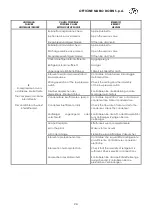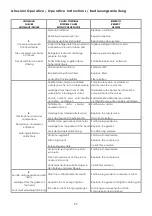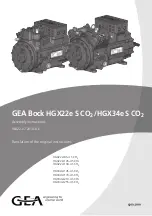
Istruzioni Operative / Operative Instructions / Bedienungsanleitung
11
tenderebbero a occupare la
parte inferiore dell’ambiente
circostante si raccomanda di
porre l’aspirazione del sistema
di ricambio aria in posizione
ribassata
.
COLLEGAMENTO DELLE TUBAZIONI
Prima
di
procedere
all’installazione
del
compressore,
scaricare
la
pressione
di
precarica
agendo
su
entrambi
i
rubinetti. Non rimuovere alcun
componente
dal
compressore prima di aver
effettuato questa operazione.
Procedere
all’installazione
come segue:
-
Rimuovere i rubinetti del
compressore;
-
Saldare i rubinetti alle
tubazioni dell’impianto;
-
Rimontare i rubinetti sul
compressore;
-
Eseguire la verifica delle
perdite
dalle
tubazioni
mediante prova in pressione
con
N
2
o
aria
secca,
seguendo tutte le procedure
di sicurezza necessarie, come
ad esempio l’impiego di un
riduttore
di
pressione
interposto tra la bombola e
l’impianto
e
lasciando
i
rubinetti
del
compressore
chiusi (ATTENZIONE! Durante
questa prova non superare la
pressione di standstill);
-
Aprire i rubinetti del
compressore;
-
Rimuovere
l’aria
dall’impianto mediante vuoto
fino a minimo 1,5 mbar;
-
Procedere alla carica
del refrigerante nell’impianto.
! Attenzione:
Non usare il compressore per
fare il vuoto.
Non
alimentare
elettricamente il compressore
in condizioni di vuoto!
lowest part of the surrounding
space we recommend to
place the suction of the air
exchange system in a lower
position
PIPES CONNECTION
Before starting the installation
of the compressor, discharge
the pressure of pre-charge by
acting on both service valves.
Do
not
remove
any
component
from
the
compressor before having
executed this operation.
Execute the installation in the
following way:
-
Remove the service
valves of the compressor;
-
Weld
the
service
valves to the system pipes;
-
Reassemble
the
service
valves
on
the
compressor;
-
Check the leaks from
the pipes by means of a
pressure test with N2 or dry
air following all the required
safety procedures such as,
for example, the use of a
pressure
reducer
placed
between the bottle and the
system
and
leaving
the
compressor service valves
closed (ATTENTION! During
this test do not overcome the
standstill pressure);
-
Open
the
service
valves of the compressor;
-
Take away the air of
the system by means of the
vacuum till a minimum of 1,5
mbar;
-
Fill up the system with
refrigerant.
! Attention:
Do not use the compressor to
create a vaccum
Do not feed electrically the
compressor
in
vacuum
conditions!
Da
etwaig
ausströmendes
Kältemittel dazu neigt sich in
Bodennähe des umliegenden
Raumes auszubreiten, ist es
ratsam das Belüftungssystem in
tiefer Position einzubauen.
Rohranschluss
Vor
der
Installation
des
Verdichters
den
Druck
der
Schutzgasfüllung durch die zwei
Absperrventile ablassen. Vor
diesem Eingriff, keinen Teil vom
Verdichter entfernen.
Die
Installation
wie
folgt
durchführen:
-
Die Absperrvenile des
Verdichters entfernen;
-
Die Absperrventile an die
Anlagenrohre anlöten ;
-
Die Ventile wieder auf
den Verdichter montieren;
-
Die Dichtheit der Rohre
durch einen Druckprüfung mit
N
2
oder
Trockenluft
kontrollieren. Dabei sind alle
Sicherheitsvorschriften
zu
beachten wie z.B. Verwendung
eines Druckminderers zwischen
der Gasflasche und der Anlage
und die Absperrventile am
Verdichter
geschlossen
zu
halten
(ACHTUNG!
Überschreiten Sie bei dieser
Kontrolle nicht den Stillstand-
Druck);
-
Öffnen Sie die Verdichter
Absperrventile;
-
Saugen
Sie
durch
Vakuum die Luft aus der
Anlage bis zu einem Minimum
von 1,5 mbar ab;
-
Füllen Sie das Kühlmittel
in die Anlage.
! Achtung:
Verwenden Sie den Verdichter
nicht um das Vakuum zu
erzeugen.
Schließen Sie den Verdichter
nicht an das Stromnetz an wenn
er sich im Vakuum-Zustand
befindet!













































